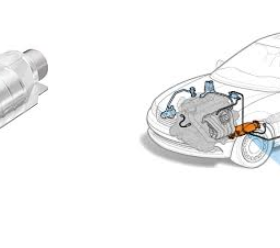“They’re going after the solid raw materials,” he said.
“They cook it down to the point where no one’s going to put the effort in to find where it came from.”
“I’m pretty sure most of it goes out of the country so no one asks any questions,” he said.
Sawyers thinks the materials aren’t being sold to auto shops, necessarily, but pawn shops,
who’ll buy the solid metals and ask few questions.
He also suggeste that there are organize groups running converter unlimited schemes,
a theory he came to by identifying the methods by which the parts were remove.
He said one presumed group uses a specific tool that “makes a very clean, straight cut. It’s very identifiable.”
Another presumed group appears to use a different sort of tool that “can go through a chunk of exhaust pipe in 10 seconds.”
“If they spend five minutes doing this,” he said, “they’re lazy. It’s so stupid easy to do. I think that’s part of why it became such an issue, the catalytic converters are just hanging there. It’s literally two bolts and one cut.”

the wholesale parts manager at a San Francisco Toyota dealership, estimated that there was a period when the dealer was selling
“a couple hundred catalytic converters a month.”
He said the most common vehicles that thieves hit are 2004 to 2009 Toyota Priuses, which he thinks are easier to steal from. The Prius catalytic converters are also known to contain a higher volume of precious metals.
“It’s sad,” he said. “I’ve seen customers pick their car up after getting the part replaced, and literally within the same day, it’s stolen again.”
When asked about the rash of Prius catalytic converter thefts
, and whether they’re planning to design vehicles that are more difficult to steal from, Toyota headquarters offered the following statement: “Catalytic converter theft is an industry-wide challenge
We want to remind drivers to follow the basics to protect their vehicles against theft – such as parking as close to entrances as possible in well-lit areas.
While not the solution to the problem as a whole, taking preventative measures like smart parking and adding the Vehicle Identification Number (VIN) to the catalytic converter can help protect drivers from theft.”
Everyone interviewed for this story agreed the best way to protect your vehicle from theft is to park in a well-lit garage — an expensive commodity often hard to come by in San Francisco and neighboring cities.
The police spokespeople also stressed the importance of providing investigators with photos and video footage, if possible.
“Video cameras, pictures, anything that you can do that you think might help, submit what you have, file a report,” Lobsinger said. “A report does two things: It gives us more to look into. And it shows us where there’s been a rash of thefts.
The more we’re aware of these incidents, the better we can deploy our resources and tailor our investigations.”
Sawyers had other suggestions. He said the cages and plates sometimes work to deter theft, but only if “somebody with less of a hassle is parked next to you and they go after that one instead.
“It only works if there is lower-hanging fruit nearby,” he said.
I got $200 for it.
I bought a used Prius, perhaps despite my best judgment, upgrade my car insurance to cover catalytic converter thefts and, in the meantime, am hoping for the best.

